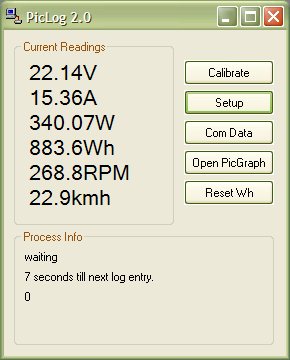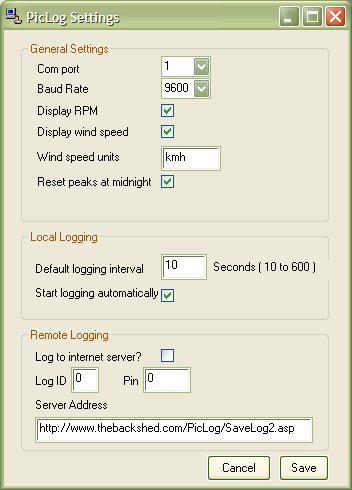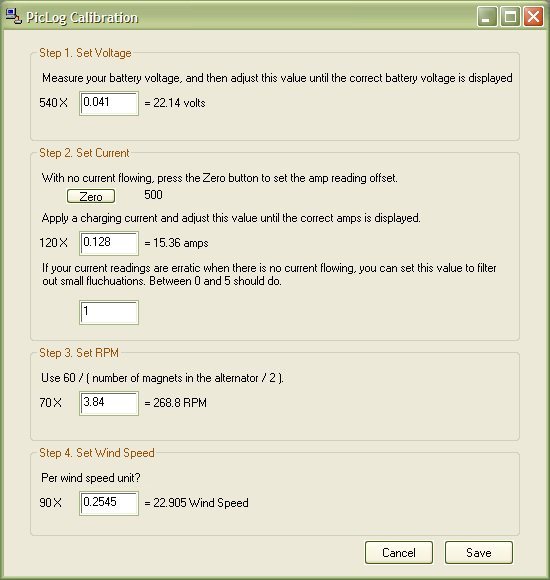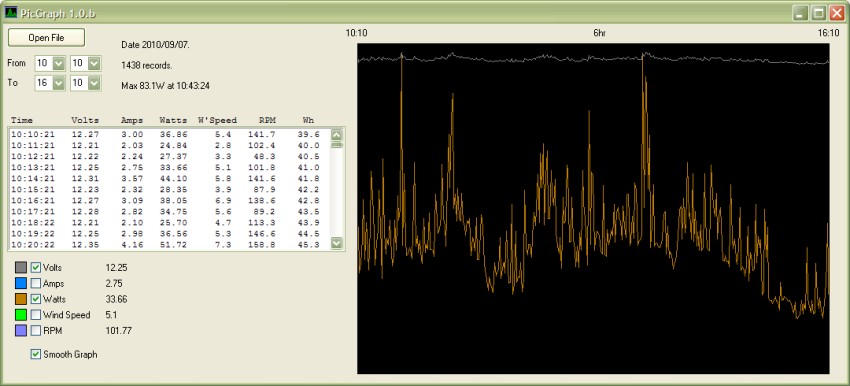 |
|
|
Site Navigation
Projects & Information
»General Information»Wind turbine Projects »The F&P Smartdrive »Electronic projects »Microcontroller projects »Miscellaneous Kits & Parts
»Basicly Natural Pty Ltd»PVC & Aluminium blades »Scale model farm windmills »Price Watch Discussion Forums
Handy Links
»Wind»Solar »Electric Vehicles »Electronics »Micro Controllers »General Interrest About TheBackShed Getting Started Privacy Policy |
The new piclog ( 2.0 ) has a few changes from the original PicLog ( 1.3 ). I've removed the excel file export function, as well as the html page export. I've even taken out the graphing screens, but not completely, the graphing side of the new PicLog is a now a new separate program called PicGraph. Separating the graphing code from the logging code has a few advantages: first up its easy to update the programs individually; the logging program can concentrate on logging only; and you can have several graphs open at once. If your upgrading from a earlier version of PicLog, PicLog 2 uses new setup and calibration files, so its not just a matter of copying the new PicLog into the old directory and expecting it to work, you need to go through the setup process again. You can use your original calibration values, but you need to do a little maths first. The old PicLog used a divider to convert the PicAxe information into real world values, however PicLog 2 uses a multiplier. Using a multiplier means simpler code within the program, and eliminates divide by zero errors, a common problem of the previous PicLog versions. To convert your old divider values into multipliers, use New Number = 1 / Old Number. So if your voltage divider was 31.4, then 1 / 31.4 = 0.0318, the new multiplier value. As well as the standard PicAxe based logger, PicLog 2 was also designed to work with Pete's Power Logger. Pete's logger includes a data checksum in the serial data, and PicLog 2 understands how to use this checksum to ensure the data received is not corrupt. The checksum is a good idea, so I've included a updated PicAxe code in the zip file ( bottom of page ) so existing PicLog's can be updated to use the checksum feature. PicLog 2 will work with either versions of PicAxe code, you don't need to update your PicAxe to use PicLog 2 PicLog 2 also includes the new online logging ability, where its data can be pushed to a remote web server over the internet. You can then use any PC on the internet to see your logger data. If you would like to use this feature, you will need a unique ID and pin number, send me a message and I'll set it up for you. See http://www.thebackshed.com/piclog/ PicLog 2.0 screens. The colours may be different on your computer, but the program operation will not be affected. |
||||
PicGraph 1.0.b screen. PicGraph is in early development at time of writing, I wanted to get the new PicLog out as soon as possible and haven't had time to give PicGraph any more than the most basic of features. I will continue to develop PicGraph over the next few weeks.
The files.
The zip file includes the logfiles directory, with a couple of sample files. The PicAxe folder has the updated PicAxe source code. A note about the open source nature of this project. I've rewritten the PicLog in Just BASIC, a free to download and use language, for the followng reasons. To give others the opportunity to learn a programming language, to understand how a logging software application works, to develop their own versions of the PicLog to suit their own needs, and to share. I ask, in fact I insist, that if you do develop any project based on the PicLog, or to interface with the PicLog, that you also share your software with everyone else on the forum, and you include the full source code, so others can learn from what you have done. If you wish to develop your own projects based on what you have learned from the PicLog, but don't wish to share the code openly with others, say for a commercial reason, then you may not use the PicLog name or icons. If you find a bug or have a suggestion to improve the PIcLog system, please share it with others on the forums or contact me on the About TheBackShed.com page. Download PicLog 2 and PIcGraph 1 Note - Non English speaking countries. There have been a couple of problems brought to my attention for PC's set to languages other than English. First up, the JustBasic run time file wont work corectly in some Asian countries. Secondly, the serial data from the PicAxe is converted to the characters of the selected language on the PC. As the PicLog program is written to look for specific english characters, this can cause it to not reconise the datastream. The solution for these problems is to run the PC with English as its language. Thanks Pete for sorting this one out. If wish to play with and understand the PicLog source code, you can download Just BASIC for free from here. |
|||||





